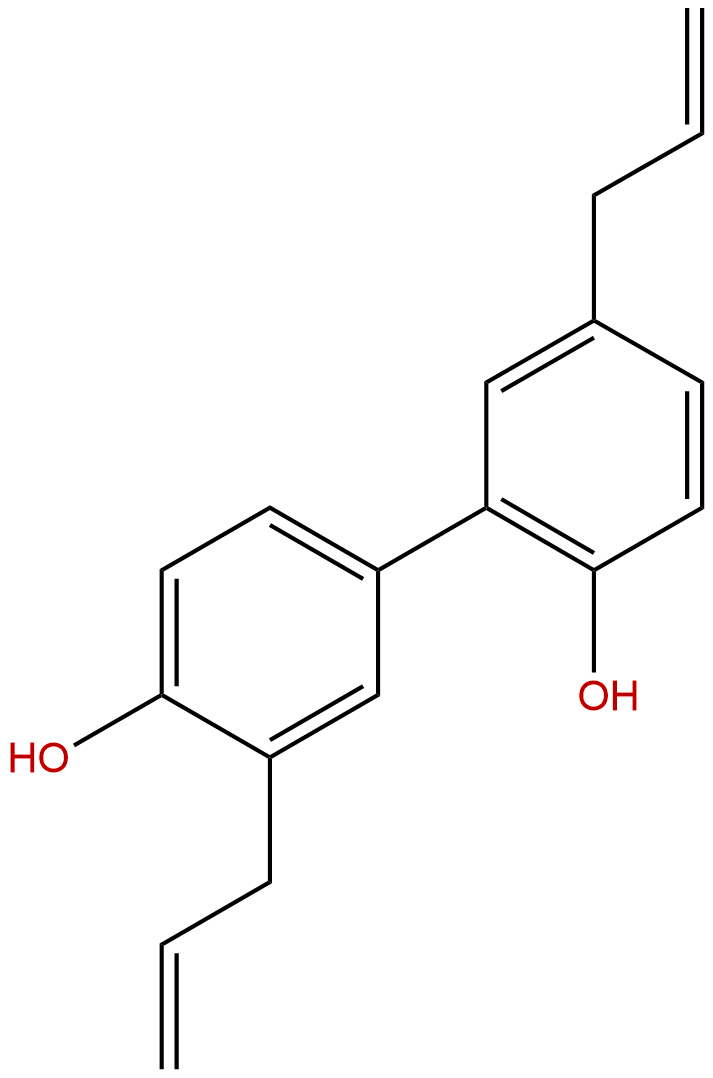
HonokiolCAS No.:35354-74-6
|
||||||||||
 |
|
|
||||||||

| Catalogue No.: | BP0736 |
| Formula: | C18H18O2 |
| Mol Weight: | 266.34 |
Product name: Honokiol
Synonym name:
Catalogue No.: BP0736
Cas No.: 35354-74-6
Formula: C18H18O2
Mol Weight: 266.34
Botanical Source: Magnoliae officinalis cortex
Physical Description:
Type of Compound: Lignans
Purity: 95%~99%
Analysis Method: HPLC-DAD or/and HPLC-ELSD
Identification Method: Mass, NMR
Packing: Brown vial or HDPE plastic bottle
Storage: Store in a well closed container, protected from air and light. Put into refrigerate or freeze for long term storage.
Whenever possible, you should prepare and use solutions on the same day. However, if you need to make up stock solutions in advance, we recommend that you store the solution as aliquots in tightly sealed vials at -20℃. Generally, these will be useable for up to two weeks.
The product could be supplied from milligrams to grams
Inquire for bulk scale.
Description:
Honokiol has antibacterial, anti-angiogenesis, antidepressant-like, antioxidant, anti-inflammatory and anti-cancer effects. It inhibited the activation of Akt and enhances the phosphorylation of ERK1/ERK2. It can improve learning, memory impairments and neuroinflammatory processes induced by SCOP in mice, by inhibition of AChE activity.
References:
J. Biol. Chem., 2003, 278(37):35501-7.
Honokiol, a Small Molecular Weight Natural Product, Inhibits Angiogenesis in Vitro and Tumor Growth in Vivo.
Natural products comprise a major source of small molecular weight angiogenesis inhibitors.
METHODS AND RESULTS:
We have used the transformed endothelial cell line SVR as an effective screen of natural product extracts to isolate anti-angiogenesis and anti-tumor compounds. Aqueous extracts of Magnolia grandiflora exhibit potent activity in our SVR proliferation assays. We found that the small molecular weight compound Honokiol is the active principle of magnolia extract. Honokiol exhibited potent anti-proliferative activity against SVR cells in vitro. In addition, Honokiol demonstrated preferential inhibition of primary human endothelial cells compared with fibroblasts and this inhibition was antagonized by antibodies against TNFα-related apoptosis-inducing ligand. In vivo, Honokiol was highly effective against angiosarcoma in nude mice.
CONCLUSIONS:
Our preclinical data suggests that Honokiol is a systemically available and non-toxic inhibitor of angiogenesis and should be further evaluated as a potential chemotherapeutic agent.
Eur J Pharmacol. 2004 Aug 2;496(1-3):189-95.
In vitro antibacterial and anti-inflammatory effects of honokiol and magnolol against Propionibacterium sp.
Honokiol and magnolol, two major phenolic constituents of Magnolia sp., have been known to exhibit antibacterial activities. However, until now, their antibacterial activity against Propionibacterium sp. has not been reported.
METHODS AND RESULTS:
To this end, the antibacterial activities of Honokiol and magnolol were detected using the disk diffusion method and a two-fold serial dilution assay. Honokiol and magnolol showed strong antibacterial activities against both Propionibacterium acnes and Propionibacterium granulosum, which are acne-causing bacteria. The minimum inhibitory concentrations (MIC) of Honokiol and magnolol was 3-4 microg/ml (11.3-15 microM) and 9 microg/ml (33.8 microM), respectively. In addition, the killing curve analysis showed that magnolol and Honokiol killed P. acnes rapidly, with 10(5) organisms/ml eliminated within 10 min of treatment with either 45 microg (169.2 microM) of magnolol or 20 microg (75.2 microM) of Honokiol per ml. The cytotoxic effect of Honokiol and magnolol was determined by a colorimetric (3-(4,5-dimetyl-2-thiazolyl)-2,5-diphenyl-2H-tetrazolium bromide) (MTT) assay using two animal cell lines, human normal fibroblasts and HaCaT. In this experiment, magnolol exhibited lower cytotoxic effects than Honokiol at the same concentration, but they showed similar cytotoxicity when triclosan was employed as an acne-mitigating agent. In addition, they reduced secretion of interleukin-8 and tumor necrosis factor alpha (TNF-alpha) induced by P. acnes in THP-1 cells indicating the anti-inflammatory effects of them. When applied topically, neither phenolic compound induced any adverse reactions in a human skin primary irritation test.
CONCLUSIONS:
Therefore, based on these results, we suggest the possibility that magnolol and Honokiol may be considered as attractive acne-mitigating candidates for topical application.
Prog Neuropsychopharmacol Biol Psychiatry. 2008 Apr 1;32(3):715-25.
Antidepressant-like effects of the mixture of honokiol and magnolol from the barks of Magnolia officinalis in stressed rodents.
Honokiol and magnolol are the main constituents simultaneously identified in the barks of Magnolia officinalis, which have been used in traditional Chinese medicine to treat a variety of mental disorders including depression.
METHODS AND RESULTS:
The mixture of Honokiol and magnolol at 20 and 40 mg/kg significantly attenuated CMS-induced decreases of 5-HT levels in frontal cortex, hippocampus, striatum, hypothalamus and nucleus accumbens. And it markedly increased 5-HIAA levels in frontal cortex, striatum and nucleus accumbens at 40 mg/kg and in frontal cortex at 20 mg/kg in the CMS rats. A subsequent reduction in 5-HIAA/5-HT ratio was found in hippocampus and nucleus accumbens in the CMS rats receiving this mixture. Furthermore, the mixture of Honokiol and magnolol reduced elevated corticosterone concentrations in serum to normalize the hypothalamic-pituitary-adrenal (HPA) hyperactivity in the CMS rats. It also reversed CMS-induced reduction in platelet AC activity, via upregulating the cyclic adenosine monophosphate (cAMP) pathway. These results suggested that the mixture of Honokiol and magnolol possessed potent antidepressant-like properties in behaviors involved in normalization of biochemical abnormalities in brain 5-HT and 5-HIAA, serum corticosterone levels and platelet AC activity in the CMS rats.
CONCLUSIONS:
Our findings could provide a basis for examining directly the interaction of the serotonergic system, the HPA axis and AC-cAMP pathway underlying the link between depression and treatment with the mixture of Honokiol and magnolol.